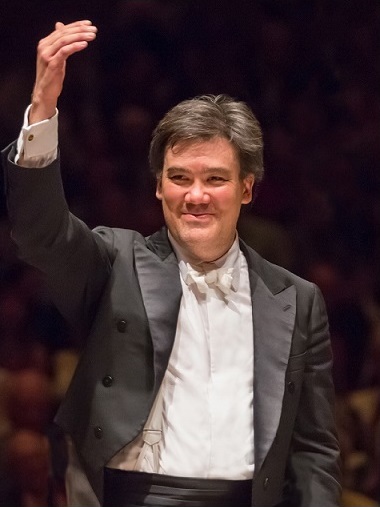A spellbinding Beethoven Fifth shows the New York Philharmonic in hale health at 175

Alan Gilbert conducted the New York Philharmonic in a 175th anniversary concert Wednesday night at David Geffen Hall.
If you think classical music is a niche market in America now, try to imagine 1842.
That was the year a transplanted New Yorker from New England named Ureli Corelli Hill, just back from studying violin in Europe, launched the first permanent symphony orchestra on this side of the ocean with an inaugural concert on December 7.
Wednesday night that orchestra, the New York Philharmonic, celebrated the day before its 175th birthday in a concert of works by Weber and Beethoven that were played on that inaugural program. They also played a piece improbably “attributed to Mozart” that at least showcased some fine wind playing by four Philharmonic principals.
Much as one would like to have been in the Apollo Rooms on lower Broadway that winter night in 1842, it’s unlikely one would have heard as polished a performance of Weber’s Overture to Oberon as Alan Gilbert led on Wednesday.
And it’s hard to imagine that orchestra, or any other, outdoing Wednesday’s performance of Beethoven’s Fifth Symphony, the most spellbinding account of the all-too-familiar masterpiece that this listener has ever heard.
The 1842 concert, a mixed bag of orchestral, vocal and chamber selections, actually began with the Fifth, as if to establish the new ensemble’s serious intentions, before going on to less weighty matters. (Unusually for that time, they even played the whole thing straight through without inserting other items between the movements.)
Wednesday’s program followed a more familiar template, one that these days is more honored in the breach than the observance: overture, concerto, symphony. It turned out to be a case of saving the best for last.
Which is not to take anything away from the evocative Oberon, with its mysterious, horn-punctuated near-silences and its tuneful allegro. This Romantic overture has been delighting audiences from 1842 (and before) to today, and Gilbert showed why in a performance of exemplary energy and charm.
It was disingenuous of the Philharmonic to market the ensuing Sinfonia concertante in E-flat major as a piece by Mozart, when James M. Keller’s program notes honestly described the piece’s tangled and dubious provenance, and one’s own ears refused to accept this conventional stuff as coming from the mind of the master.
In any case, the piece, true to its arcane genre, sounded like a wind quartet with minimal (too minimal, perhaps, in this performance) orchestral backup. The four admirable soloists—Liang Wang, oboe; Anthony McGill, clarinet; Judith LeClair, bassoon; and Richard Deane, horn—squeezed more juice from its brilliant passagework and lyrical phrases than maybe even its composer, whoever he was, knew it had.
But with the famous first four notes of Beethoven’s symphony, one felt the level of performance rising from good to wow. Clearly conductor Gilbert had resisted the temptation to skimp on rehearsal time for a piece the orchestra could likely have played from memory. Over and over, one marveled at the finely-placed detail, the balance and tone chemistry tuned just right, the musicians’ intense concentration in the moment.
All this, however, was in the context of a performance that seemed to fly ahead on a rhythmic impulse arising directly from Beethoven’s score. Economical of gesture yet fully engaged on the podium, Gilbert appeared to ride the wave and direct it at the same time.
At the first movement’s exhilaratingly fast (but rock-steady) tempo, the exposition seemed to be over in no time, and its repeat was welcome. In the development section, the four-note motive swarmed especially thick through all the sections, wonderfully audible in the transparent orchestral texture.
Gilbert moved the Andante right along, “con moto” as marked, giving its mellow theme a long expressive arc. Beethoven’s later manipulations of it with sudden interruptions, modulations and dynamic changes—events whose effect has become dulled by familiarity—sounded on Wednesday almost as startling, even a little unhinged, as they must have when Beethoven first wrote them.
The Scherzo was a satisfying study in contrasts: furtive main theme, then horns striding in seven-league boots, then a racy fugato driven by the percussive sound of horsehair biting strings. The theme’s pizzicato return sounded ineffably droll, but there never were more ominous timpani taps than the ones that underlay the famous crescendo leading to the finale.
Gilbert made sure the brassy outburst at the end of that crescendo was juicy and satisfying, but hardly the end of the matter. The finale was an exciting and eventful piece of its own, not just a tiresomely extended coda, as in some performances of this work. In fact, Gilbert had enough confidence in his conception of the piece to go back and start it all over again with Beethoven’s indicated exposition repeat, an instruction few conductors follow.
His confidence was well placed. This taut performance, far from seeming long-winded, grasped the listener’s attention and never let go. The tempo bumped up progressively in the closing pages, making Beethoven’s notoriously never-ending coda sound like just the right conclusion to this symphony’s thrilling trip.
As soon as Gilbert cued the long final chord, a wave of applause rose up and blotted out his cutoff, a spontaneous demonstration rare at Philharmonic performances these days.It didn’t end until he had returned to the stage three times and signaled individual bows to what seemed like half the players in the orchestra.
At that moment, the New York Philharmonic seemed like a spry 175-year-old indeed.
The program will be repeated 7:30 p.m. Thursday, 2 p.m. Friday, and 8 p.m. Saturday. nyphil.org; 212-875-5656.






